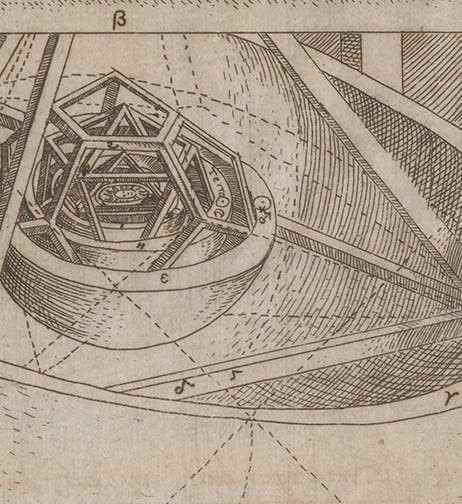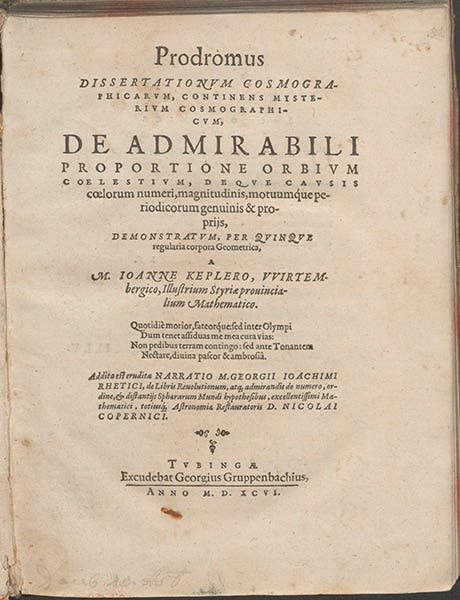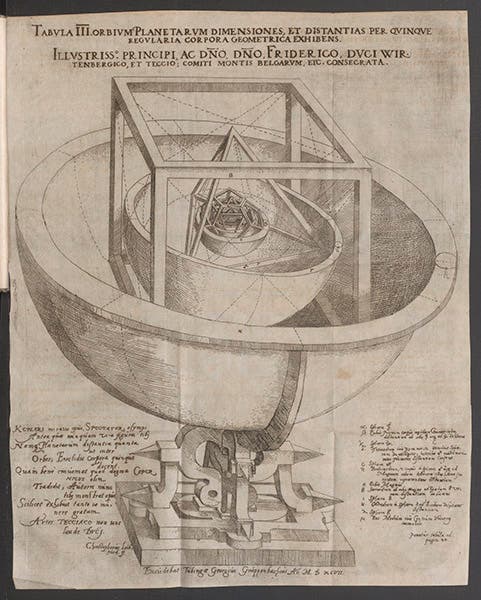Scientist of the Day - Johannes Kepler
Johannes Kepler, a German astronomer, was born Dec. 27, 1571. We celebrated his birthday two years ago, with a post on the frontispiece that accompanied one of his last works, the Rudolphine Tables of 1627. Kepler, however, is worthy of multiple celebrations, and today we discuss his very first book, the Prodromus, or Mysterium cosmographicum (Cosmographic Mysteries) of 1596. Kepler had just graduated from the University of Tübingen and had accept a minor teaching post in Graz in southern Austria. At the time, he was pondering what were (for Kepler) two of the mysteries of the cosmos: Why are there 6 and only 6 planets (Kepler was a Copernican, so the Earth was now a planet, but the Sun and Moon were planets no longer)? And why are the planets spaced the way they are, in such an irregular fashion? Kepler was already a thorough-going Platonist, and his God was a Geometer, who used principles of harmony and proportion everywhere in his creation. Everything in the cosmos must have a geometric reason, including the number and spacing of the planets.
Kepler tells us that he found the answer while diagramming the cycle of Great Conjunctions for his students (second image). Jupiter and Saturn come into alignment every 20 years (a Great Conjunction), each conjunction occurring almost 120 degrees apart in the zodiac. If the outer circle in the diagram represents the zodiac, and you draw a straight line between successive conjunctions, you will trace out a series of slowly rotating equilateral triangles. These triangles define another circle inside them. Kepler realized while doing this that the diameters of the inner and outer circles are in almost the same ratio as the diameters of the orbits of Jupiter and Saturn. This was his "aha!" moment. He immediately guessed that God had used some kind of nested geometric shapes to define the sizes of the planetary orbits. It did not take Kepler long to suspect that the ideal geometric shapes for a perfect universe were the five perfect solids, also known as the Platonic solids because of their appearance in Plato's Timaeus. Each Platonic solid defines two spheres, inscribed and circumscribed, so a nest of Platonic solids will define six spheres, one for each of the six planets. The only thing left to do was to determine the correct order of the nested solids, and see if the spacing of the spheres is correct.
Kepler was able to figure this out, and he immediately published his first book, Cosmographic Mysteries, to announce his solution to the world (third image). The highlight of the book is the folding engraving that depicts the cosmic nest of Platonic solids, with the cube as the outside solid, followed by the tetrahedron, the dodecahedron, the icosahedron, and the octahedron as the innermost solid (fourth image). In the detail that opens this post (first image), one can see the Sun smiling within the octahedron, pleased no doubt that Kepler has discovered his secret.
Kepler realized even before finishing the book that the nested solids did not exactly account for the real spacing of the planets, and that some other harmonic principle must be involved. But he was so pleased with the concept that he published the book anywhere, believing, we would surmise, that God ought to have designed the solar system this way. He remained proud of his insight all his life; indeed, this was the only one of his books that he reprinted, in 1621. We have both editions in our History of Science Collection.
We bought our copy of the 1596 edition at the auctions of the Honeyman Collection, 1978-81. Robert Honeyman had slipcases made for many of his books, all in red buckram, and we show here the case for Kepler's Prodromus (fifth image). We have a number of similar red cases scattered through our vault, and they look fine that way, diluted by assorted volumes in vellum, pigskin, and marbled boards. We are not sure that an entire library of red buckram would have been quite so visually appealing.
The portrait of Kepler we show here, by Hans von Aachen, is not known for certain to depict Kepler, but we like it better than the ones that are known portraits. If anyone demonstrates that this cannot portray our astronomer, we will replace it with one of the conventional portraits.
Dr. William B. Ashworth, Jr., Consultant for the History of Science, Linda Hall Library and Associate Professor emeritus, Department of History, University of Missouri-Kansas City. Comments or corrections are welcome; please direct to ashworthw@umkc.edu.











